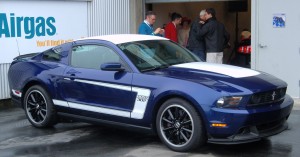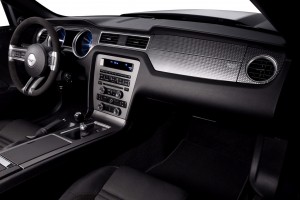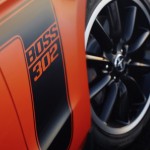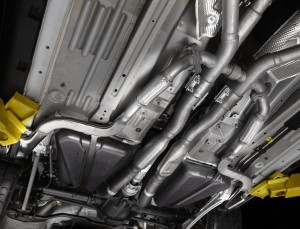
The 2012 Ford Mustang Boss 302 will be available in a limited number of color combinations including Kona Blue Metallic.
Hot on the heels of the new Mustang GT comes the 2012 version of the Mustang Boss 302, carrying on a Ford tradition that started in 1969 with the introduction of the original Boss 302 (302 is the number of cubic inches in the Boss 302’s 5.0-liter V-8 engine). The new one will pack 440 horsepower and 380 foot-pounds of torque, and a whole host of improvements to its body, chassis, suspension, wheels and tires.
The original Boss 302 was homologated for the Sports Car Club of America’s Trans American Championship Series, or Trans Am, when Mustang, Cougar, Camaro, Firebird, AMC Javelin, Dodge Challenger and Plymouth Barracuda all raced against each other for supremacy in the ponycar segment of the market.

A dark metallic instrument panel finish, gauge cluster and door panel trim differentiate the Boss interior.
Ford will also offer a limited number of Boss 302 Laguna Seca models, named for the track where Parnelli Jones won the 1970 Trans-Am season opener in a Boss 302. Aimed at racers more interested in on-track performance than creature comforts, the Boss 302 Laguna Seca has increased body stiffness, a firmer chassis set-up and an aerodynamics package carried over from the Ford Racing Boss 302R.
 Ford says a new intake system was essential, a plenum/velocity stack combination the engine team developed. Revised camshafts using a more aggressive grind are actuated with the same twin independent variable camshaft timing (Ti-VCT) mechanism used on the Mustang GT. More aggressive control calibration yielded 440 horsepower and 380 foot-pounds of torque. The engine has a forged crankshaft, forged connecting rods, and forged pistons, and can rev to 7,500 rpm.
Ford says a new intake system was essential, a plenum/velocity stack combination the engine team developed. Revised camshafts using a more aggressive grind are actuated with the same twin independent variable camshaft timing (Ti-VCT) mechanism used on the Mustang GT. More aggressive control calibration yielded 440 horsepower and 380 foot-pounds of torque. The engine has a forged crankshaft, forged connecting rods, and forged pistons, and can rev to 7,500 rpm.
A racing-style clutch with upgraded friction materials transmits power to a close-ratio six-speed manual transmission fitted with a short-throw shifter. A 3.73:1 ratio rear axle using carbon fiber plates in the limited-slip differential improves torque handling and longevity. A torque-sensing (Torsen) limited-slip differential is an available option coupled with Recaro front seats.
The Boss 302 features a unique quad exhaust system. Two outlets exit in the rear similar to a standard Mustang GT. The other two outlets exit to either side of the exhaust crossover, sending exhaust through a set of removeable metal discs that act as tuning elements before the pipes terminate just ahead of the rear wheel opening. We heard it run, and this thing is loud!
Higher-rate coil springs on all four corners, stiffer suspension bushings and a larger-diameter rear stabilizer bar all contribute to the road racing mission, and Boss models are lowered by 11 millimeters at the front and 1 millimeter at the rear versus the Mustang GT. Easily adjustable shocks and struts are standard on all Boss Mustang models, with five settings for the shocks. The Mustang team opted for traditional race-style hands-on adjustability, similar to the Gabriel shocks available on the original Boss 302. The shock adjustment is right at the top of the shock tower, built into the rod and easily accessible from under the hood or inside the trunk, adjustable with a small flat-head screwdriver.
The Boss 302’s speed-sensitive electronic steering system has been retuned with three settings on the instrument cluster menu: comfort, normal and sport. Boss 302s get a unique traction control system (TCS) and electronic stability control (ESC) settings to help drivers achieve maximum performance whether on the street or at the track. Both systems can be completely disabled.
Lightweight 19-inch black alloy racing wheels in staggered widths, 9 inches in front, 9.5 inches in the rear, are standard on the Boss 302. Pirelli PZero summer tires are sized specifically for each end of the vehicle, with front 255/40ZR-19 tires and rear 285/35ZR-19 rubber.
Brembo four-piston front calipers act on 14-inch vented rotors up front. In the back, standard Mustang GT brakes are upgraded with high-performance pad compound, combined with vented brake shields and unique Anti-Lock Brake System (ABS) tuning.
Design cues from the ’69 Boss 302 street car and race cars are updated to give the 2012 the proper look. To set Boss 302s apart, each car will have either a black or white roof panel, coordinated to the color of the side C-stripe. Available exterior colors are Competition Orange, Performance White, Kona Blue Metallic, Yellow Blaze Tri-Coat Metallic and Race Red.
Prices were not announced at the introduction held at Mazda Raceway at Laguna Sea during the Monterey Motorsports Reunion weekend, but these cars will be very, very expensive compared to garden-variety GTs.

